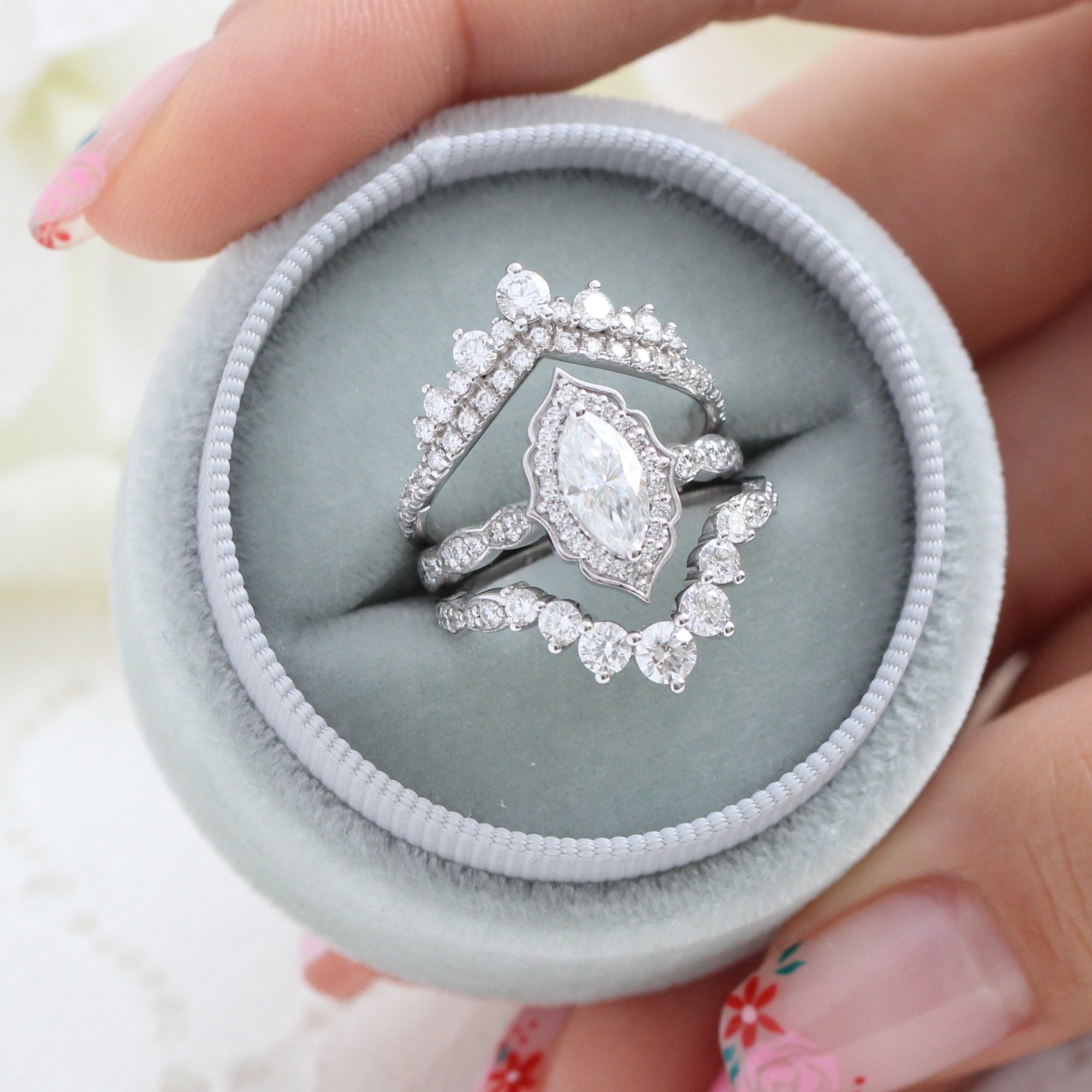
14K vs. 18K White Gold: A Side by Side Comparison
Continuing from our previous blog post comparing 14k and 18k Rose Gold, we’d like to now compare the difference between 14k and 18k white gold.
To better understand white gold and the difference between 14k and 18k white gold, it's important to first have a grasp on gold and its purity. As we've previously discussed, the unit used to measure the purity of gold is karat, with 24 karat gold being the purest form (99.99% pure). One karat contains 1/24 pure gold, or about 4.17% pure gold, and a piece with a higher karat amount has a higher gold content.
While pure 24 karat gold has a brilliant yellow color, it is quite soft, which makes it unsuitable for use in jewelry. To make it more durable for jewelry, especially for bridal rings, it is typically alloyed, or mixed, with other metals, creating lower karat golds like 14k or 18k.
The image below you can see the color difference between a solid gold coin and a solid 14k rose gold band.

14k gold contains about 58% pure gold; the remaining 42% is an alloy of metals such as silver and copper.
18k gold contains about 75% pure gold; the remaining 25% is the alloy.
Now that we have a basic understanding of gold, its purity, and its alloys, let's compare how 14k and 18k white gold measure up.
Durability
Gold is a sought-after material in jewelry making because of its flexibility and malleable. However, the higher the concentration of pure gold in a piece of jewelry, the more prone it is to scratches and bending. For example, an 18k white gold ring is less durable than a 14k white gold ring and requires careful handling. To create jewelry that can withstand daily use, gold must be mixed with other more durable metals, thus creating a metal alloy.
Of note: White gold jewelry is distinct from rose gold or yellow gold jewelry. This is because white gold jewelry is coated with a layer of rhodium, which provides an additional layer of protection. Thanks to this extra layer of protection, an 18k white gold ring will not wear out as easily as an 18k rose gold or yellow gold ring.
Purity & Appearance
The term “white gold” is a bit of a misnomer due to the fact pure gold is actually yellow; there is no such thing as “white” or “rose” natural gold. Since pure gold is naturally yellow, the white sheen of white gold is achieved by first alloying the gold with other metals such as silver and nickel. Mathematically, 14k white gold contains about 58% pure gold and 42% silver and nickel alloys while 18k white gold contains about 75% pure gold and 25% silver and nickel alloys.
Below you can see the band castings in 14k and 18k white gold:
As you can see, at the casting stage 14k and 18k white gold are still quite yellowish, with the 18k white gold casting being more yellowish than 14k white gold casting.
Below you can see the same 14k and 18k white gold leaf bands after polishing, but without the rhodium plating yet.
Again, you can see the white gold rings still have quite a yellowish hue with the 18k white gold ring showing more yellow than the 14k white gold ring. The next step will be where the white in white gold really comes to light.
After alloying pure gold with alloys to achieve a white tone, the next step is plating the white gold ring with rhodium. Rhodium is a durable element that has a silver/white color that is very shiny and dazzling. To achieve the whitest possible finish in a white gold piece, especially pieces with higher karat of pure gold, it is rhodium plated to counteract the yellow of the pure gold.
Below is the final step in making white gold rings. Both leaf bands in 14k and 18k white gold are rhodium plated (or dipped).
As you can see, now both white gold rings have that signature white color that white gold lovers adore. Despite the karat difference of 14k and 18k white gold, both rings have an almost identical appearance.
La More Design offers the option of creating engagement rings and wedding bands in either 14k, 18k gold, or platinum. We frequently receive inquiries from customers seeking guidance on which metal to select. However, the ultimate decision should always be based on personal preference, just like choosing a partner. We advise you to follow your heart and choose the ring that feels ideal for you.
FAQs:
Q: Does your white gold ring have to be re-dipped over time?
A: To maintain the pristine white appearance of your white gold ring, it will need to be periodically re-dipped or re-plated with rhodium. Over time, the rhodium plating will wear off, revealing the yellowish hue of the gold underneath. However, this is a sign that our jewelry at La More Design is made with genuine, solid gold. To put your mind at ease, we offer a free cleaning service, including re-plating your white gold ring(s) upon request, as part of our warranty.
Q: What is Rhodium?
A: Rhodium, with a current trading price of $12,850 per ounce as of July 11th, 2022, is the most expensive among all precious metals, surpassing gold's $1,750 per ounce and silver's $19.18 per ounce. Due to its rarity and high cost, solid jewelry made of rhodium is uncommon. Instead, it is commonly utilized as a coating for white gold or platinum jewelry to enhance their lustrous silver-white appearance and provide additional protection to these valuable items.

The image above showcases a timeless elegant white gold bridal ring stack of a halo pear engagement ring pairing beautifully with matching curved diamond wedding bands.
Would you prefer 14k or 18k white gold for your dream ring?
Read more Blog Posts to discover the latest jewelry trends, product launches, and more!





